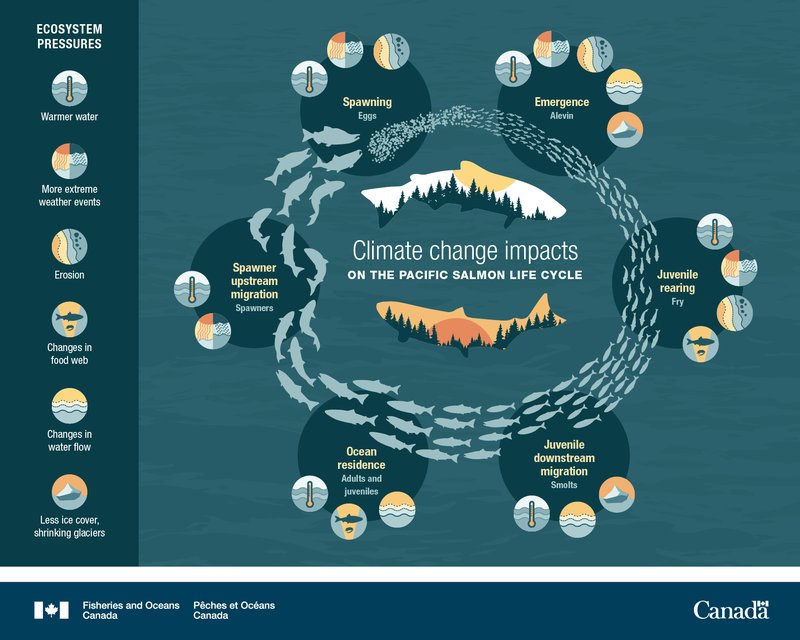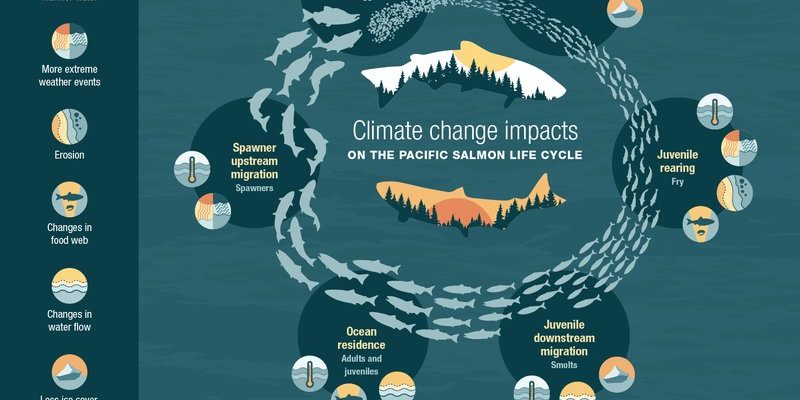
Let’s dive into how climate change affects salmon, from rising water temperatures to changing migration patterns, and what that means for ecosystems and us. Just like that family member who always shows up late to dinner, climate change is causing serious disruptions that we can’t ignore.
Rising Water Temperatures
Salmon thrive in cool, clear waters, and they’ve adapted to specific temperature ranges. When the climate heats up, those waters can become warmer than salmon can handle. This might sound like a small change, but it has big consequences. Warmer water holds less oxygen, which makes it harder for salmon—especially juvenile ones—to survive.
Here’s the thing: if juvenile salmon can’t find the oxygen-rich waters they need, their growth stunts, and they become more vulnerable to predators. Imagine trying to swim in a pool where the water keeps getting warmer—eventually, it’s just too uncomfortable to stay in. With less oxygen in the water, salmon populations can face serious declines, impacting not just the fish but also everything that depends on them, from bears to fishermen.
Altered Migration Patterns
Salmon are famous for their incredible migrations, traveling from freshwater rivers to the ocean and back again. But climate change is throwing a wrench into this well-tuned journey. Changes in water flow and temperature can disrupt these migrations. For example, summer droughts can reduce river flow, making it harder for salmon to swim upstream to spawn.
Plus, with climate change causing rapid fluctuations in weather, salmon are facing conditions they’re not used to. Think about it: if you were trying to navigate a busy city with constantly changing traffic patterns, you’d probably get lost or delayed. Salmon are experiencing something similar, which means fewer of them make it back to their spawning grounds. This ultimately leads to lower fish populations and can threaten the entire ecosystem.
Impact on Spawning Habitats
Salmon lay their eggs in gravel beds in river systems, which are sensitive to temperature and water flow. With climate change contributing to increased rainfall and flooding, these habitats can get washed away or become unsuitable. If the eggs can’t survive in the gravel due to high water temperatures or strong currents, the entire lifecycle of salmon is at risk.
Imagine if a baker suddenly found that their favorite ingredients were spoiled or unavailable. They wouldn’t be able to make the same delicious bread. In a similar way, if salmon can’t find the right conditions to lay their eggs, we may see a drastic decrease in salmon populations. This loss not only affects the fish but also the species that rely on them for food.
Changing Food Web Dynamics
Salmon play a crucial role in their ecosystems, acting as a key food source for many animals, including bears, eagles, and even humans. As climate change alters the habitats and behaviors of salmon, it’s not just the fish that suffer. The creatures that depend on them for food must adapt or face starvation.
Consider the web of life like a domino effect. If one piece falls—like salmon populations declining—other parts of the ecosystem are affected. Bears may find it harder to catch fish during migration season, leading to less food for their cubs. If this continues, we could see a shift in biodiversity, with some species thriving while others struggle to survive.
Effects on Fishery Industry
The salmon fishing industry is vital for many communities, providing jobs and food security. However, as climate change disrupts salmon populations, fishery yields may decline. Fishermen who depend on stable salmon runs might find themselves facing empty nets.
This creates a ripple effect, where not only are fishermen affected, but families relying on freshly caught salmon for dinner also feel the pinch. Imagine relying on your favorite local bakery, only to find it’s closed due to ingredient shortages; it’s frustrating and can significantly change your daily life. The same is true for coastal communities where salmon fishing is central to their way of life.
Conservation Efforts
Despite these challenges, there is hope. Conservation efforts are underway to help protect salmon and their habitats. This includes habitat restoration, pollution control, and sustainable fishing practices. By understanding how climate change affects salmon, we can work together to implement solutions that not only protect the fish but also support entire ecosystems.
For example, planting trees along riverbanks can provide shade, which helps keep water temperatures down. This small action can benefit salmon tremendously, giving them cooler, oxygen-rich water to live in. Additionally, educating local communities about the importance of healthy rivers and sustainable practices can foster a shared responsibility toward these precious resources.
Climate change is a complex issue, but when it comes to its impact on salmon, the effects are clear and concerning. From rising water temperatures to altered migration patterns, the challenges faced by salmon are multifaceted and interconnected. These changes don’t just impact the fish themselves but ripple through ecosystems and communities that depend on them.
By understanding these challenges, we can take steps—big and small—to protect salmon and the delicate balance of life they help support. It takes all of us to ensure that future generations will still have the opportunity to enjoy this amazing species. If we come together, we can create a better future for salmon and, ultimately, for ourselves.

